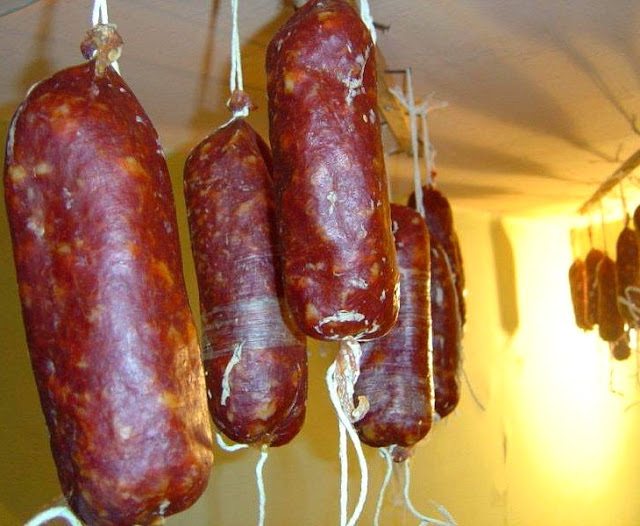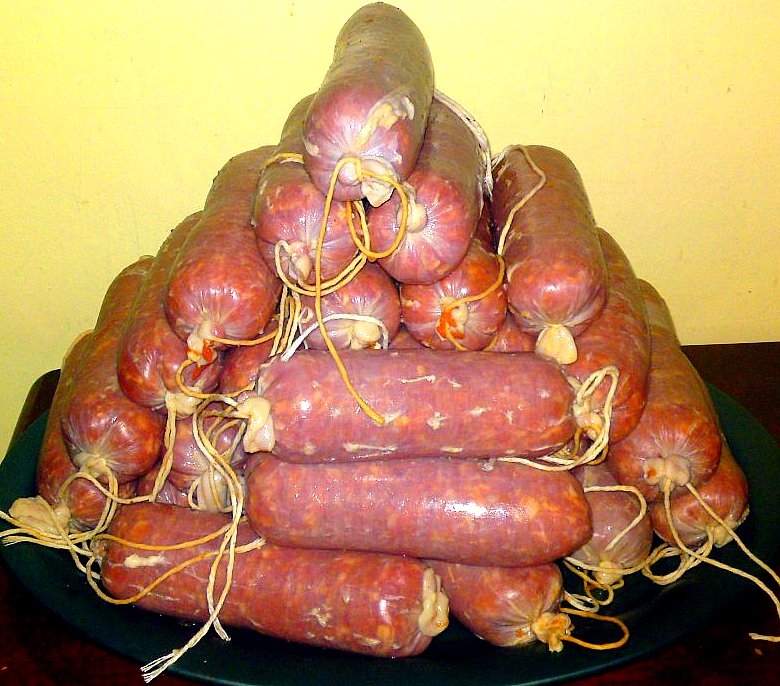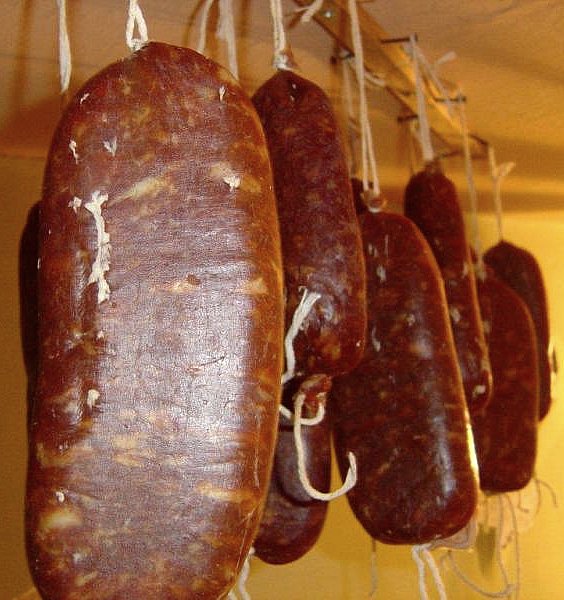
Pennsylvania Salami Makers: Homemade Soppressata or “Soupie”
In Calabria, the salumi sopressata (see my guide to salumi) enjoys PDO or Protected Designation of Origin status meaning any salami labeled as Sopressata di Calabria must be entirely manufactured (prepared, processed AND produced) within the specific region according to traditional methods. Sopressata received its name from the practice of pressing the salami between pieces of wood resulting in a straight, flattened shape (click here for more articles on salumi and charcuterie).



The “coal region” is a span of central PA that was made popular back in the 1800’s/early 1900’s due to the enormous amounts of anthracite coal found in the area. Pair that with the global need for coal as an energy source at the time and it’s easy to see how our area became popular very quickly. Hundreds of thousands of immigrants flocked to this area during that time because of the demand for cheap labor from the coal companies, and among those immigrants was a large percentage of southern italians, specifically Calabrese. This area became a melting pot of ethnic foods and customs from Italian to Irish to German to Polish and many others. Unfortunately many of the traditions are disappearing, if they haven’t disappeared already, but one tradition that is very much alive and well is making “soupie”.
The specific area of the coal region where I am from (the western end, made up of towns like Mount Carmel, Kulpmont, Atlas, Shamokin, Locust Gap, etc) not only had a large amount of Calabrese immigrants, but specifically from one small village in Calabria called Isca (Isca is located on the easter side of Calabria, along the Mediterranean and Ionian seas). This is where our beloved soupie came from and was one of many foods that were brought over and remained a strong part of the italian communities in our area, though it is one of the last that still remains popular. It is so popular, in fact, that many of the younger generations really have no idea when or where it came from or even that it’s “Italian.” They only know that their dads and/or uncles made it, and their dads and uncles before them, and if anything, it is a “coal region” thing and it is made by everyone in this region, not just those with Italian heritage.
In our family, my wife and I are the soupie makers (with help from my dad), however many men get together with friends/brothers/cousins for soupie weekends where cellars and garages throughout the coal region take on an almost “superbowl” atmosphere, usually with plenty to eat and drink. Women are not usually among those involved in making soupie in our area.
Each group of guys have their own “secret ingredient” or a secret ratio of the main ingredients(salt, pork, some form of red pepper), and of course, everyone’s are “the best.” This thinking among soupie makers in our area has spawned “soupie bowls” which are basically taste testing contests to see whose soupies are the best. Many businesses and local news stations have become part of the anual contests and have even expanded to include pasta dishes and homemade wine in the judging.


I learned how to make soupie years ago by a great woman who was born and raised in Isca (also where my family is from) and she not only showed me how to make them with great detail, but explained why her family made them, how they raised their pig and what it meant to have it so they could cure it’s meat and contine to live off of it for months to come. How she would stuff the casings with the ground pork with nothing but her thumbs. It gave me a great deal of pride and respect for our soppressata that my own family makes, not because we need it to survive anymore, but because our great grandparents and everyone before them did.My wife and I are currently building a house and we spent an hour talking with the builder on where we could put vents/windows to have cross ventilation so we could hang our soupie. The builder never heard of them and was amazed that I would put so much importance on this seemingly minor detail but as I explained to him in great detail about supressata and what it means to us, he was as determined as I was on getting the ventilation right(which we did).
Thanks for the great story, Matt!


Awesome feature, Vince, and great write-up Matt! As both of you know, I grew up in the Coal Region (Matt’s relatives basically surrounded me in my hometown!) and now live in the area of Calabria our ancestors came from; I have to say it’s always a special moment whenever I bite into a piece of soupie/supressata here, and it takes me right back to my kitchen table in Atlas munching on some that my grandfather (Lithuanian, not an ounce of Italian blood) made…yes indeed the supressata has gone global, especially in the Coal Region 😉
Oh man, i grew up with these! I sure could go for a soupie right about now!!
What part of the coal region does this fabulous tradition take place? I have relatives in Scranton and live in Carlisle. I am just starting to cure meat as part of the charcutepalooza project.
Loved this article. Takes me back to my Nono’s (born in Calabria) attic where I always saw “soupies” hanging. (circa 1940). The only difference was Nono’s soupies were all irregular shapes. You have improved upon them, Matt. Nothing beats sitting around on a Fall day with a small plate of soupies, cheeses, fruits, some good wines and/or homemade liquors.
Hi Christine,
From what Matt states the main sections of PA are all on the western end, “made up of towns like Mount Carmel, Kulpmont, Atlas, Shamokin, Locust Gap, etc.”
The charcutepalooza project is very cool, we made duck prosciutto!
Vince
Very cool, Michelle, I thought there was a connection when I remembered you were from PA originally. Soupie has, indeed,gone global!
Vince
Yes Vince — I’ve known Matt since kindergarten 🙂
I really enjoyed reading this feature Vin, thank you for sharing about the “soupie” tradition.
Hello that looks great.I had the pleasure of attending a Soupie contest several years ago.I had made friends with Art Catino.I live in Chicago Il.since then I have had my own contest,last year we had over 380 people in attendence and 40 contestants.Trying to keep the tradition alive!!!! Frank Balestri aka the Sodfather.You can view my Instuctional video on youtube titled Sodfather.
Frank Balestri’s 6th Annual Soppresatta contest in Chicago Il.Sunday April7th Fundraiser for the 100 Club of Chicago–The Chicago Police Memorial Foundation.Lets support are Fallen Officer’s!!!!
What’s the recipe Vince?
This is an excellent and very informative write-up. I am from the PA coal region and had only been introduced to soupie a few years ago. My uncle had cut a sliver of some meat product he called “soupie” on a hunting trip one day, and from there I had a new obsession. I never even stopped to think about how it’s made or where it came from, as I thought it was some typical meat snack from a butcher shop. Thanks to both of you, Vincent and Matt, for enlightening me on the matter. Maybe now that I have a better understanding of soupie, I can try my hand at making it sometime.
Great story Vince. I live in the Coal Region and have been fortunate enough to not only learn the tradition of soupie making but be a judge at some local soupie contests. There are four annual soupie contests in the Shamokin-Mount Carmel, Pa., area: Forest Hill Fire Co, Coal Township, Maine Fire Co, Coal Twp., Mount Carmel American Legion, Mount Carmel Twp., and the West End Fire Co, Kulpmont. As many as 50 different soupies have been entered by groups of men who make them to compete for the coveted Pig Trophy!
Vince-It’s like I hit the JACKPOT today when I found your site!!!! I’m from Western PA also (Apollo, PA). Just 2 years ago, my husband and I decided to try to make Sopresatta, as his parents did many years ago. The parents are deceased, so we searched the web, read books, and gave it a try. WE LOVED IT!! We will always be learning, and think that we can learn so much from your site. As January approaches, we just can’t wait to start thionking about SOPRESATTA.
Very neat! Thanks for visiting and I’m glad you enjoy the site. Making salumi is tough stuff so all the best to you!
My parents are both from Mount Carmel and I have had a bunch of different soupies from a lot of different places out there. We all live in south Jersey now, but when we go back to Mount Carmel, (Knoebels Amusement Park) for our family reunions, we always stock up on soupies. It’s most definitely a big deal when someone breaks one out and slices it up. The store brands are so lacking, it’s not even worth buying them, (I’ve tried them all). I am at the point where I will be creating my own. Here’s a great side story, years ago I owned a barbecue joint in GA, and a foodservice mgr. came into my place and his last name was Scicchitano. We got to talking and of course, his family was from the coal region. Long time ago, and I don’t remember his first name, but I asked him if he had any soupies. The next day he dropped one off at the store. Of course he got my business.
My roots are in Mount Carmel although lining in Ohio. Anyone seeing the name Scicchitano would instantly think the person is from the coal region. I’ve met countless people in my neck of the woods from home (significant other still thinks the coal region isn’t home for me although born in Ohio; it’s still home to me) . Making Paps soupie this winter, based off the Clovers recipe. Pray to God it comes out good. Remember as a kid making it with him with the guys, hopefully remember everything right!
You can take a boy from the coal region, but never take the coal region out of the boy!!!!
Great article. My parents were born in Shamokin and my dad’s family came from Calabria. In fact my grandmother’s maiden name was Scicchitano. I remember my uncles making “soupie”.
Hi….does anyone know where I can buy equipment to make the soupies quickley….ie. grinders, etc and also why do they have to be pressed before hanging? thanks
Story. My mom (Calabrese) made soppresatta for many years. In 2005, evidently she made some, cured it, stuck in in a vat of olive oil, stuck it in her storage bin and lost her short term memory. I was finally cleaning out the bin and found it. I cleaned one, took off the skin and it’s still good. It is not as red as it should be, but it didn’t turn. Safe to eat? I’ll let you know!
I never had soupie till we moved to the coal region. I love them! 🙂
Thanks for a great article, my brothers and I are learning the art of making soppresata from my father who is also from Isca. It’s really an honour to continue these traditions for future generations. It’s just a little hard to tell when the drying is complete but I guess we’ll have to learn with practice.
Love it!!